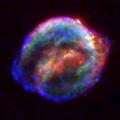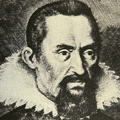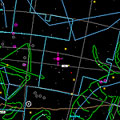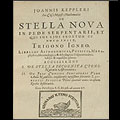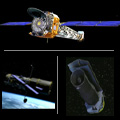An overview of the Chandra mission and goals, Chandra's namesake, top 10 facts.
Classroom activities, printable materials, interactive games & more.
Overview of X-ray Astronomy and X-ray sources: black holes to galaxy clusters.
All Chandra images released to the public listed by date & by category
Current Chandra press releases, status reports, interviews & biographies.
A collection of multimedia, illustrations & animations, a glossary, FAQ & more.
A collection of illustrations, animations and video.
Chandra discoveries in an audio/video format.
Kepler's Namesake: The Man Behind the Remnant
October 29, 2004 ::
Recently, NASA's three Great Observatories -- the Hubble Space
Telescope, the Spitzer Space Telescope, and the Chandra X-ray
Observatory - produced an extraordinary image of the Kepler supernova
remnant. This combined effort reveals the remains of a shattered star
in optical, infrared, and X-ray light that will help astronomer better
understand how some stars die.
But what about the man himself - who was Kepler and why does this object
bear his name?
Four centuries ago, an evening's entertainment was as simple as stepping
out to gaze at the night sky. But among the world's many star watchers
one man stood apart.
Johannes Kepler (1571-1630) was a mathematician and
physicist who not only observed, but also sought to explain the
celestial dance above.
A rather frail young man, the exceptionally talented Kepler turned to
mathematics and the study of the heavens early on. When he was six, his
mother pointed out a comet visible in the night sky. When Kepler was
nine, his father took him out one night under the stars to observe a
lunar eclipse. These events both made a vivid impression on his youthful
mind and turned him toward a life oriented to the study of astronomy.
Kepler used simple mathematics to formulate three laws of planetary
motion. Kepler's First Law stated that planets move in elliptical paths
around the Sun. He also discovered that planets move proportionally
faster in their orbits when they are closer to the Sun, and this became
Kepler's Second Law. Finally, Kepler's Third Law explained the
relationship between the distance of a planet from the sun and the
amount of time it took to orbit the Sun. Together these laws of
celestial mechanics revolutionized astronomy.
"The era in which Kepler lived was one of tremendous upheaval and
change," said
Dr. Dan Lewis, curator of the history of science &
technology at the Huntington Library in San Marino, Calif. "Religious
leaders were reluctant to relinquish the idea that the heavens were the
perfect creations of God.
Talk by astronomers of a sky filled with
objects moving in non-circular orbits and other phenomena that went
against an Earth-centric model threatened their beliefs. As a result,
Kepler and his first wife, Barbara, created a code with which to write
letters to each other so that their correspondence would not put them at
risk of persecution."
Near the end of the sixteenth century, Kepler apprenticed himself to
the astronomical observer Tycho Brahe, who had an observatory on the
island of Hven in Denmark. The somewhat eccentric Tycho, who had lost a
portion of his nose in a duel and replaced the tip of it with a
contraption made of gold and silver, was nevertheless a brilliant
astronomer. Kepler absorbed a great deal of information from his time
working for Brahe, and based much of his later calculations on Tycho's
observations.
As for the supernova remnant that now bears his name, several observers
spotted the supernova on October 9, 1604, over a week before Kepler
did. Once the cloudy skies cleared for Kepler, he began his
observations on October 17. (This supernova might be the youngest
supernova in the Milky Way. The possible exception is the Cassiopeia A
supernova remnant, for which ambiguous sightings were reported around
1680.)
Initially, the Kepler supernova brightened and surpassed Jupiter in
brilliance within a few days -- which was fortunate since the telescope
would not be invented for another five years. It was still about as bright as
Jupiter when it became invisible in twilight of November, but continued
to visible in the night sky until March 1606. This meant skywatchers
had naked-eye visibility of the supernova for some 18 months. From
Kepler's observations, astronomers have suspected that the supernova of
1604 was a Type Ia supernova. These events are thought to be caused
when a white dwarf collapses because it has pulled too much material
from a nearby companion star onto itself.
Even though Kepler wasn't the first to see this supernova, he studied
the event so extensively that it was named after him. (The results of
his observations were disseminated through book, De Stella Nova,
published in Prague in 1606.) The Kepler supernova is now a remnant, but
it is still studied by astronomers, including those of NASA's three
Great Observatories.
Kepler was deeply driven by a desire to understand the analytical "why"
of astronomy, well beyond the descriptive "what" of his predecessors
Ptolemy and Tycho. He was also guided by a notion of beauty in the
structure of the universe. In his words, "Happy is the man who devotes
himself to the study of the heavens; their study will furnish him with
the pursuit of enjoyments."

